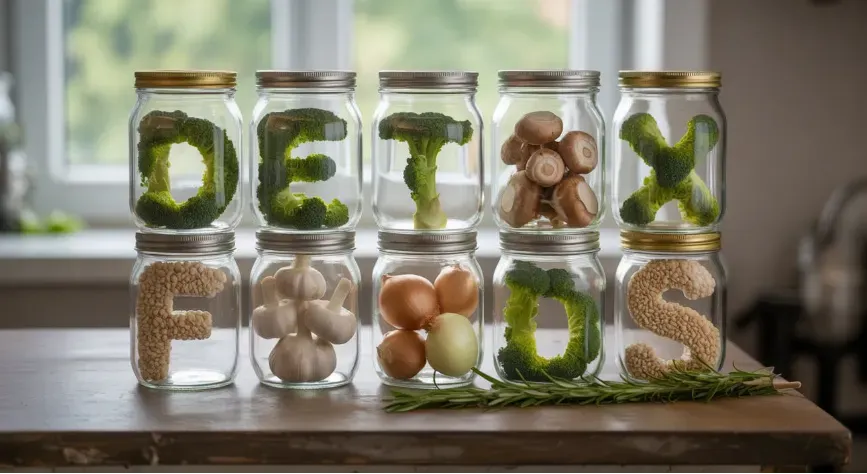Detoxifying the Body from Microplastics: Natural Approaches That May Help
Key takeaways
- Microplastics enter mainly through food and water, accumulating in organs and the brain.
- Glutamine, fiber, hydration, and sulfur-rich foods support natural detox pathways.
- Lifestyle habits like sleep, sweating, exercise, and autophagy activation further aid clearance.
- Reducing daily plastic exposure lightens the detox load on the body.
Strengthening the Gut Barrier
Glutamine and Intestinal Integrity
Most microplastics enter through food and water. Because they’re so small, they can slip through the gut lining into the bloodstream. The amino acid glutamine strengthens tight junctions in the intestinal wall, helping to reduce absorption.
Glutamine can be found in powdered supplements, but it’s also naturally present in bone broth, collagen peptides, and grass-fed meats. By reinforcing the gut barrier, fewer plastic particles may pass into circulation.
Soluble Fiber for Elimination
Studies show that 94% of human stool samples contain microplastics, highlighting the importance of effective elimination. Soluble fermentable fiber binds with bile in the intestines, creating a gel that can trap microplastics and escort them safely out of the body.
Good sources include chia seeds, carrots, sauerkraut, chicory root, and konjac fiber (glucomannan). Regular intake supports both digestion and detoxification.
Supporting Natural Filtration Systems
Hydration and Kidney Health
Kidneys work continuously to filter waste, including small particles and chemical residues like BPA. Without adequate hydration, filtration slows, allowing toxins to build up.Drinking at least 2 liters of clean water daily, ideally from glass or stainless steel bottles, supports kidney function while reducing plastic exposure from containers.
Lymphatic Drainage
The lymphatic system also removes microscopic waste, but it relies on body movement. Daily habits that stimulate lymph flow include:
- Walking after meals
- Deep diaphragmatic breathing
- Gentle yoga or stretching
- Rebounding on a trampoline
- Alternating hot and cold showers

Enhancing Liver Detoxification
Sulfur-Rich Foods
Chemicals in plastics—such as BPA, phthalates, and PFAS—behave like fat-soluble toxins. The liver converts these into water-soluble forms in a process called phase 2 detoxification.
Sulfur-rich foods enhance this process by boosting glutathione, the body’s master antioxidant. Add more garlic, onions, leeks, broccoli sprouts, cabbage, and eggs to your meals for natural detox support.
Autophagy Activation
Autophagy is the body’s way of recycling damaged proteins and pollutants. Activating it may help clear persistent “forever chemicals.” The most effective trigger is fasting for 18 hours or more once or twice a week.
Other ways to encourage autophagy include lowering refined carbohydrate intake and consuming polyphenol-rich foods like green tea, turmeric, berries, and capers.
Protecting the Brain
Deep, Restorative Sleep
Emerging research shows that microplastics may concentrate in the brain up to 30 times more than in the liver or kidneys. Fortunately, the brain has its own cleaning system: the glymphatic system, which works most efficiently during sleep.
Aim for 7–9 hours of uninterrupted sleep nightly by:
- Keeping the room dark and cool
- Establishing a consistent bedtime
- Practicing relaxation to calm the mind
Fiber and Fungi Allies
Beta-Glucans
Animal studies suggest that beta-glucans can help increase excretion of persistent pollutants. Sources include shiitake, maitake, reishi, and lion’s mane mushrooms, as well as oats.
Sweating as a Detox Pathway
Research has found BPA, phthalates, and heavy metals in human sweat—sometimes in amounts not detectable in urine. This shows that sweating is another valuable clearance route.
- Regular exercise
- Sauna sessions (infrared or traditional)
- Hot baths
Since sweating also removes electrolytes, replenish with water and natural salts like Himalayan or Celtic sea salt.
Nurturing the Microbiome
Gut bacteria may play a role in breaking down plastics like polystyrene and polyethylene. But modern stressors—antibiotics, alcohol, and processed foods—can weaken this microbial shield.
- Fermented foods (sauerkraut, kimchi, kefir)
- Raw fruits and vegetables with naturally occurring wild strains
- Broad-spectrum probiotic supplements if needed
Reducing Plastic Exposure at Home
Kitchen Swaps
The kitchen is a major source of plastic contamination. Consider:- Glass containers instead of plastic storage
- Wooden cutting boards instead of plastic ones
- Ceramic or stainless steel cookware instead of nonstick coatings
- Avoiding microwaving food in plastic containers or under plastic lids
Household and Personal Care Changes
Microplastics can also enter through the skin or air. To reduce exposure:- Choose cotton, linen, hemp, silk, or wool clothing over synthetic fibers
- Swap to bamboo-handled toothbrushes
- Use HEPA filters to capture airborne dust and microplastic fibers
- Select organic cotton hygiene products instead of plastic-containing versions
